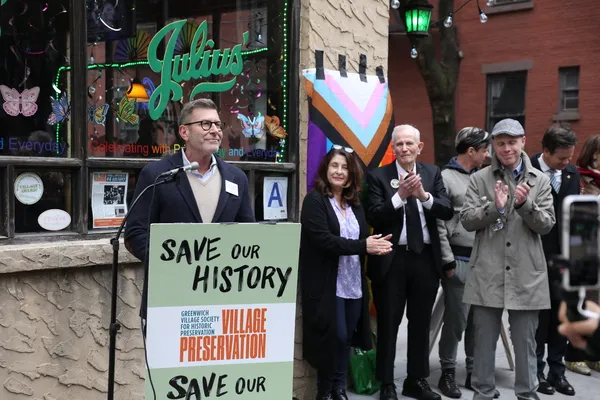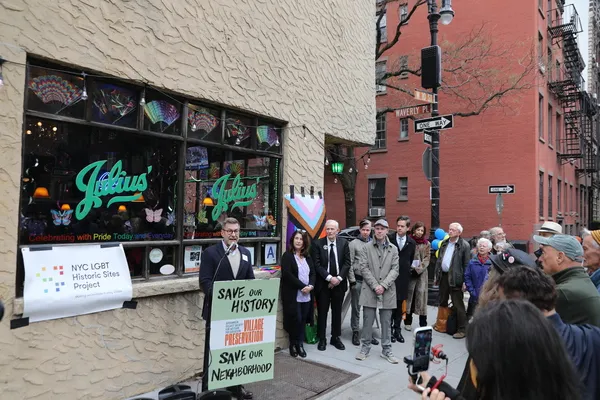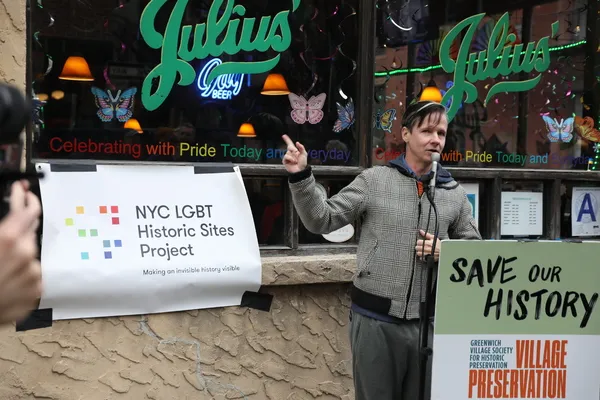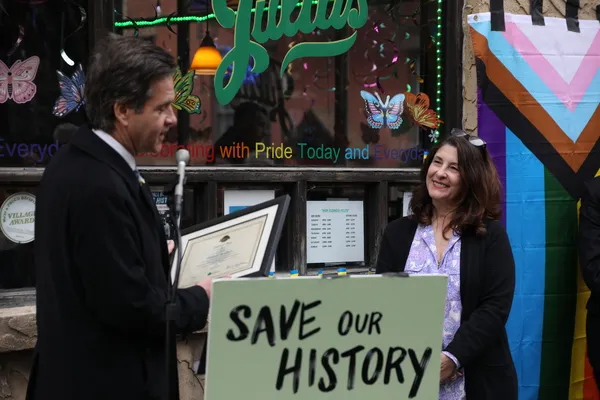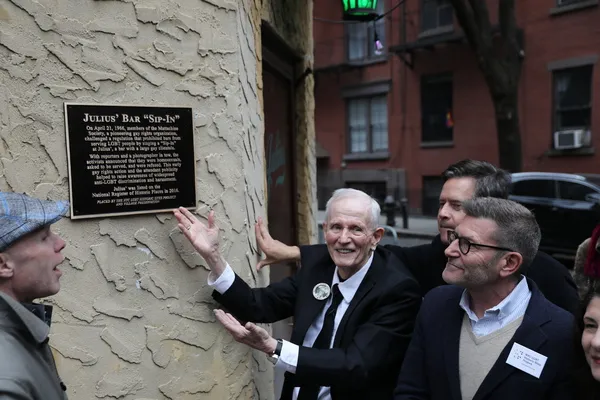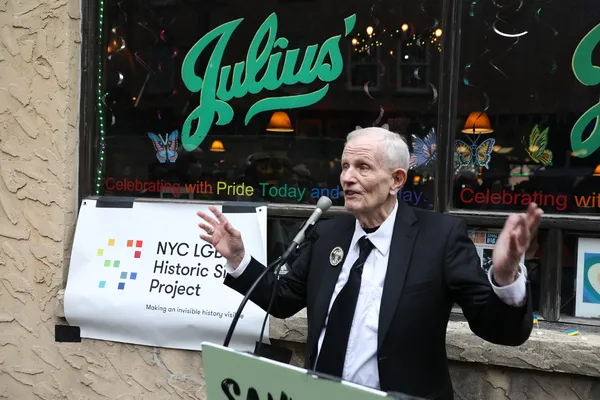Photos: John Cameron Mitchell & More Acknowledge Julius’ Significance to LGBT Activism & History
April 22, 2022
By: Chloe Rabinowitz
Activists, preservationists, historians and others gathered to honor the site of the 1966 “Sip-In” at Julius’, on 56th anniversary of event.
Yesterday, Village Preservation; the NYC LGBT Historic Sites Project; the owner of Julius’ Bar, located at 159 West 10th Street; special guest, Broadway star John Cameron Mitchell; LGBT activist and 1966 “Sip-In” participant, Randy Wicker; and others gathered for the unveiling of a plaque to acknowledge Julius’ significance to LGBT activism and history.
Check out photos below!
On April 21, 1966, members of the Mattachine Society, an early gay rights group, organized what became known as the “Sip-In” to challenge New York State Liquor Authority (SLA) regulations that were promulgated so that bars could not serve drinks to known or suspected gay men or lesbians, since their presence was considered de facto disorderly. The SLA regulations were one of the primary governmental mechanisms of oppression against the gay community because they precluded the right to free assembly. This was particularly important because bars were one of the few places where gay people could meet each other.
Mattachine members Dick Leitsch, Craig Rodwell, and John Timmons, accompanied by several reporters, went to a number of bars to document this discrimination. At Julius’, where they were joined by Randy Wicker, the group announced that they were “homosexuals” and asked to be served a drink – the bartender refused their request. This refusal received publicity in The New York Times and the Village Voice and was the first time LGBTQ discrimination had been proactively documented in mainstream media. The reaction by the SLA and the newly-empowered New York City Commission on Human Rights resulted in a change in policy and the birth of a more open gay bar culture. Scholars of gay history consider the “Sip-In” at Julius’ a key event leading to the growth of legitimate gay bars and the development of the bar as the central social space for urban gay men and lesbians.
Ken Lustbader, NYC LGBT Historic Sites Project: “Today we make an invisible history visible by installing a commemorative plaque on the exterior of Julius’ bar, an important location in LGBTQ history. In April 1966, courageous activists staged a ‘Sip-In’ to publicize the homophobic discrimination that the LGBTQ community experienced in bars, which could refuse them service if suspected of being homosexual. These pre-Stonewall trailblazers challenged the idea that LGBTQ people were second-class citizens – they deserved safe and welcoming places to socialize and build community. The NYC LGBT Historic Sites Project is proud to have undertaken extensive research and writing when nominating Julius’ to the State and National Registers of Historic Places in 2016 for LGBTQ history. Since then, we have nominated an additional ten sites directly associated with LGBTQ history. With the recent pushback of LGBTQ rights and attacks on queer people throughout the country, we’re proud to join with our partners at Village Preservation and Helen Buford, owner of Julius’, to formally memorialize this history with this tangible plaque. It will provide intangible benefits of identity, pride, and a connection to the past.”
Andrew Berman, Village Preservation: “As the city’s oldest gay bar and home of the pioneering 1966 ‘Sip-In’ protesting anti-gay discrimination, we are proud to be placing a plaque at Julius’ with our partners at the NYC LGBT Historic Sites Project to honor this uniquely important civil rights site. Three years before Stonewall, when being gay was still considered a crime, these brave individuals protested for their right to gather free from harassment and discrimination. This is part of a long tradition of pioneering efforts for civil rights for LGBTQ people, African Americans, women, immigrants, and many others rooted in this neighborhood, from the first free black settlement in North America located here in the 17th century, to the fight for Women’s suffrage here in the late 19th and early 20th centuries, to the Stonewall Rebellion and many other agitations for LGBTQ+ rights which took place here in the late 20th century. We’re thrilled to be able to add this site as our 19th historic plaque in our neighborhoods, which have marked the homes of figures from James Baldwin to Jane Jacobs, Lorraine Hansberry to LeRoi Jones, Anais Nin to Alex Haley. We’re especially proud given that in 2012 we were able to get Julius’ determined eligible for the State and National Registers of Historic Places, when few LGBTQ+ sites had ever received such a determination, and we continue to advocate for individual New York City landmark designation for the site.”
